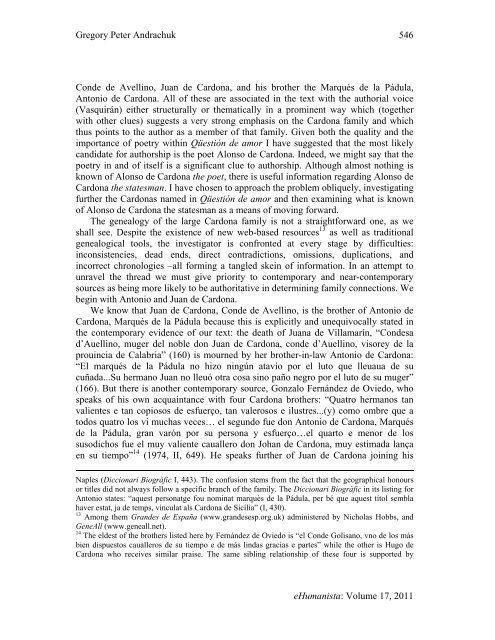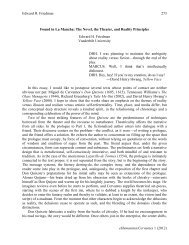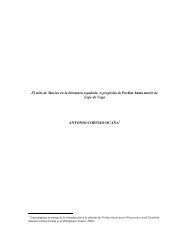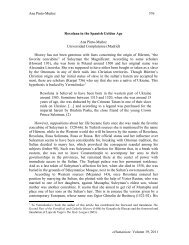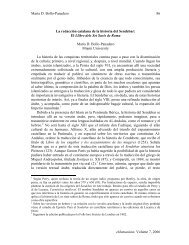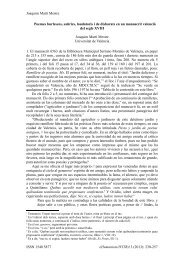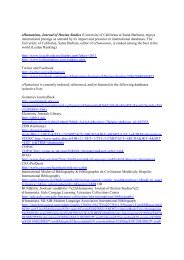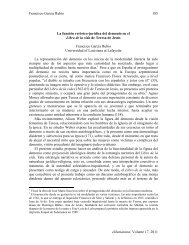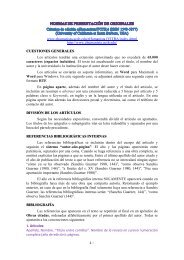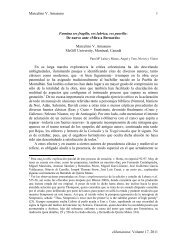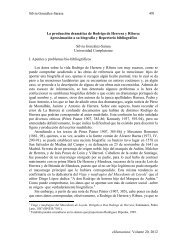Gregory Peter Andrachuk eHumanista: Volume 17, 2011 540 Alonso ...
Gregory Peter Andrachuk eHumanista: Volume 17, 2011 540 Alonso ...
Gregory Peter Andrachuk eHumanista: Volume 17, 2011 540 Alonso ...
You also want an ePaper? Increase the reach of your titles
YUMPU automatically turns print PDFs into web optimized ePapers that Google loves.
<strong>Gregory</strong> <strong>Peter</strong> <strong>Andrachuk</strong><br />
Conde de Avellino, Juan de Cardona, and his brother the Marqués de la Pádula,<br />
Antonio de Cardona. All of these are associated in the text with the authorial voice<br />
(Vasquirán) either structurally or thematically in a prominent way which (together<br />
with other clues) suggests a very strong emphasis on the Cardona family and which<br />
thus points to the author as a member of that family. Given both the quality and the<br />
importance of poetry within Qüestión de amor I have suggested that the most likely<br />
candidate for authorship is the poet <strong>Alonso</strong> de Cardona. Indeed, we might say that the<br />
poetry in and of itself is a significant clue to authorship. Although almost nothing is<br />
known of <strong>Alonso</strong> de Cardona the poet, there is useful information regarding <strong>Alonso</strong> de<br />
Cardona the statesman. I have chosen to approach the problem obliquely, investigating<br />
further the Cardonas named in Qüestión de amor and then examining what is known<br />
of <strong>Alonso</strong> de Cardona the statesman as a means of moving forward.<br />
The genealogy of the large Cardona family is not a straightforward one, as we<br />
shall see. Despite the existence of new web-based resources 13 as well as traditional<br />
genealogical tools, the investigator is confronted at every stage by difficulties:<br />
inconsistencies, dead ends, direct contradictions, omissions, duplications, and<br />
incorrect chronologies –all forming a tangled skein of information. In an attempt to<br />
unravel the thread we must give priority to contemporary and near-contemporary<br />
sources as being more likely to be authoritative in determining family connections. We<br />
begin with Antonio and Juan de Cardona.<br />
We know that Juan de Cardona, Conde de Avellino, is the brother of Antonio de<br />
Cardona, Marqués de la Pádula because this is explicitly and unequivocally stated in<br />
the contemporary evidence of our text: the death of Juana de Villamarín, “Condesa<br />
d’Auellino, muger del noble don Juan de Cardona, conde d’Auellino, visorey de la<br />
prouincia de Calabria” (160) is mourned by her brother-in-law Antonio de Cardona:<br />
“El marqués de la Pádula no hizo ningún atavío por el luto que lleuaua de su<br />
cuñada...Su hermano Juan no lleuó otra cosa sino paño negro por el luto de su muger”<br />
(166). But there is another contemporary source, Gonzalo Fernández de Oviedo, who<br />
speaks of his own acquaintance with four Cardona brothers: “Quatro hermanos tan<br />
valientes e tan copiosos de esfuerço, tan valerosos e ilustres...(y) como ombre que a<br />
todos quatro los vi muchas veces… el segundo fue don Antonio de Cardona, Marqués<br />
de la Pádula, gran varón por su persona y esfuerço…el quarto e menor de los<br />
susodichos fue el muy valiente cauallero don Johan de Cardona, muy estimada lança<br />
en su tiempo” 14 (1974, II, 649). He speaks further of Juan de Cardona joining his<br />
Naples (Diccionari Biogràfic I, 443). The confusion stems from the fact that the geographical honours<br />
or titles did not always follow a specific branch of the family. The Diccionari Biogràfic in its listing for<br />
Antonio states: “aquest personatge fou nominat marquès de la Pádula, per bé que aquest títol sembla<br />
haver estat, ja de temps, vinculat als Cardona de Sicília” (I, 430).<br />
13<br />
Among them Grandes de España (www.grandesesp.org.uk) administered by Nicholas Hobbs, and<br />
GeneAll (www.geneall.net).<br />
14<br />
The eldest of the brothers listed here by Fernández de Oviedo is “el Conde Golisano, vno de los más<br />
bien dispuestos caualleros de su tiempo e de más lindas gracias e partes” while the other is Hugo de<br />
Cardona who receives similar praise. The same sibling relationship of these four is supported by<br />
546<br />
<strong>eHumanista</strong>: <strong>Volume</strong> <strong>17</strong>, <strong>2011</strong>


